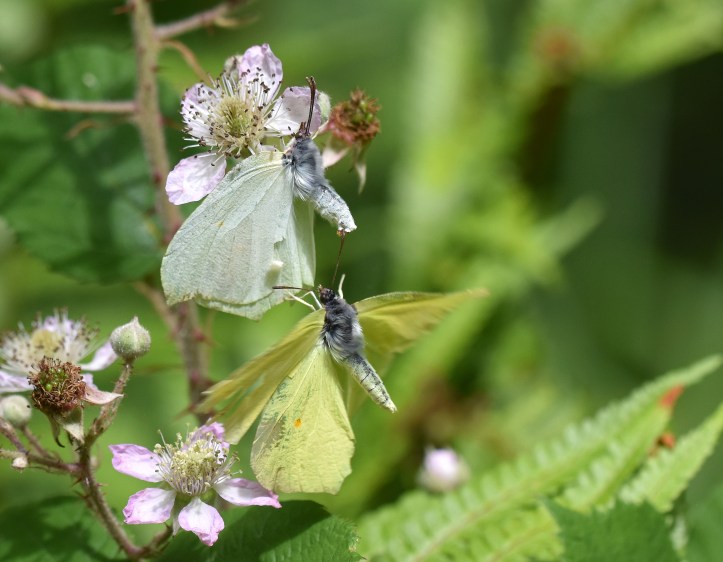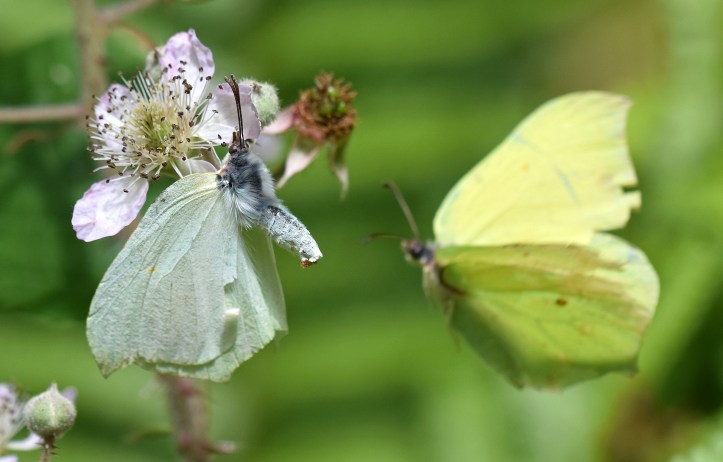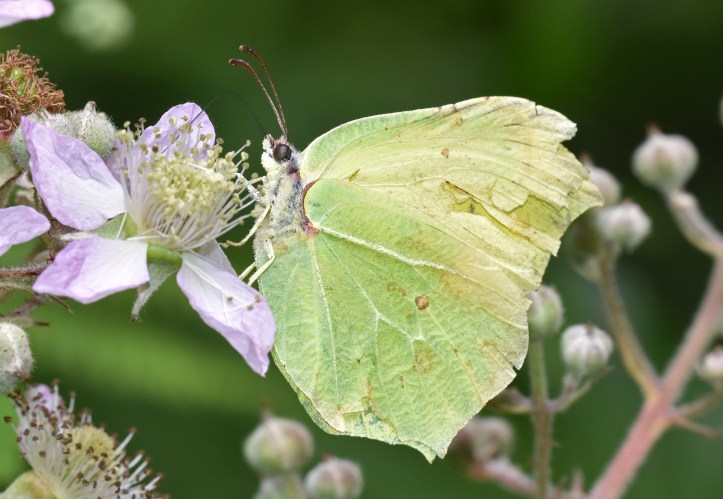
Courtship in pierid butterflies, such as brimstones, is usually fairly brief, but can nevertheless, feature some interesting interactions. I happened across a short, unsuccessful courtship in this pair of common brimstones (Gonepteryx rhamni) in NW Spain (Galicia). There are relatively few accounts of courtship in this species; however, Adrian Hoskins – informative as ever – mentions on his website (Learn about butterflies) that brimstone males are commonly seen ‘wing-walking‘ on females and this is invariably followed by a rejection posture by the female. The Wikipedia entry for Gonepteryx rhamni refers to an old text, on the Natural History of British Butterflies, by Frederick William Frohawk (1861 – 1946), which reportedly says that mating in this species occurs after a prolonged ‘dalliance flight’! Unfortunately, I did not witness any dalliance here, just the preliminaries.

The butterflies in these photos look slightly worn, but bear in mind that they are probably nearly a year old, having developed the previous summer and spent the winter hibernating, or at least resting! Due to the mild winter climate in Galicia, this species can appear all year round in northwest Spain, but mostly in June and July (Iglesias and Camino, 1992). Fresher specimens, which emerge in the following generation, can be seen later on in the summer, e.g. shown here from early September 2018.
The bright yellow wings of the male, and the small orange spot (what is its function?) are apparent in the next photograph. Bear in mind that the forewings of the male reflect ultraviolet light (Wilts et al., 2001), so he is putting on quite a display for the female! Unlike us humans, butterflies can see short-wavelength, UV light.

The male flutters all around the female, repeatedly landing on her wing and making brief contacts with the tips of his legs (second image below).

The male lands on her wing for the second time (below).

The male continued to flutter around the female, who had elevated her abdomen slightly (below). Elevated abdomens are usually a sign of non-interest! Even though her abdomen is not raised up very high, she is saying ‘No-thank you!’I think, in butterfly language.


Females of many species, particularly pierids – compare the raised abdomen by a female green-veined white, shown here – are able to avoid wasting too much time (by both partners) by adopting a mate refusal posture. The female is not just being coy, she has probably already mated. So, the raised abdomen sends a clear message, although it did not completely deter this male! Maybe her ‘No’ was not emphatic enough! Brimstone females usually only mate once, although a small proportion do mate again, after receiving a spermatophore. For example, the average number of spermatophores – which provide a record of mating frequency – found in female brimstones in a study in Sweden, was 1.20 (Wiklund et al., 2001). So brimstones are largely, but not completely monogamous.

The male did however, eventually give up and flew off to feed on a nearby flower (below). Stocking up on energy!

Brimstones males are usually ready to mate as soon as they emerge from winter hibernation, whereas females may not be in such a hurry to start laying eggs (quoting from Wiklund et al., 1996). Incredibly, the males are capable of transferring a full ejaculate – i.e. the spermatophore and its contents – within minutes of emerging from a long period of hibernation.
This sequence came about by chance. I sat down to eat a sandwich, by the banks of the Rio Sor, in NW Spain, and spotted a female brimstone butterfly resting on a dog rose flower; she did not appear to be nectaring. I idly focused my lens on her, but then the male appeared, and I started to take a series of photographs. The whole sequence (not all are shown here) took slightly less than four minutes (on 16th June 2019).
I shot this sequence in relatively low light, with a fairly shallow DOF (f/5) and a shutter speed of 1/1250ths of a second (ISO 400). I generally try to avoid flash because I think it must have an effect on the butterfly.
A very nice courtship sequence in brimstones, also illustrating some contact via the legs of the male, is featured on a blog called Postcards from Sussex. This so-called, wing-walking behaviour, is, I think, just a means of making physical contact. The male is trying to stimulate the female into responding; by visual (UV wing flashing), tactile (contacts) and who knows, perhaps ever an exchange of chemical signals, i.e. pheromones? I have also observed males gently ‘walking’ or touching females with their legs, in other pierids, such as this pair of courting Iberian marbled whites (below). Also from NW Spain.

As I often mention in these blogs, there is so much to find out about butterfly behaviour, and photographs are an excellent way of ‘freezing’ the action and allowing one to examine the interaction more closely, later. Videos are probably even more useful, but I stick to taking still photographs, because that is what I have always done! If the interaction is prolonged and repeated, it can easily be videoed, but these courtship interactions are often rather fleeting. However, they are there for all of us to witness, with a little time and patience.
Links
https://www.learnaboutbutterflies.com/Lifecycle%209%20-%20mate%20location%20courtship.htm
References
Frohawk, F. W. (1924). Natural History of British Butterflies, Vol. 2. Natural History of British Butterflies, Vol. 2.
Iglesias, X. L., & Astor Camino, X. (1992). Guía das bolboretas de Galicia. Edicións Xerais de Galicia.
Wiklund, C., Karlsson, B., & Leimar, O. (2001). Sexual conflict and cooperation in butterfly reproduction: a comparative study of polyandry and female fitness. Proceedings of the Royal Society of London. Series B: Biological Sciences, 268(1477), 1661-1667.
Wiklund, C., Lindfors, V., & Forsberg, J. (1996). Early male emergence and reproductive phenology of the adult overwintering butterfly Gonepteryx rhamni in Sweden. Oikos, 227-240.
Wilts, B. D., Pirih, P., & Stavenga, D. G. (2011). Spectral reflectance properties of iridescent pierid butterfly wings. Journal of Comparative Physiology A, 197(6), 693-702.